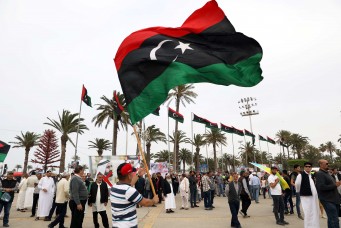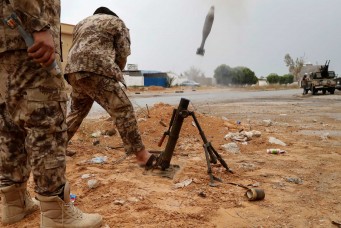Libya’s Foreign Militias
The presence of foreign armed groups in Libya’s south poses an increasing threat to local security and regional political ties.

A member of the rebel movement Sudan Liberation Army (Abdul Wahid faction) stands guard as people stand in line for the arrival of an African Union – United Nations Mission in Darfur (UNAMID) delegation to open a new clinic in Forog, north Darfur May 30, 2012. Albert Gonzalez Farran/UNAMID/Reuters
On March 13, the United Nations Support Mission in Libya (UNSMIL) issued a statement of concern at ongoing violence in Sabha, a city in Libya’s impoverished south where a flare-up in tensions since late January has to date killed a number of civilians. The area is contested between forces loyal to Field Marshal Khalifa Haftar’s eastern-based Libyan National Army (LNA) and ethnic groups aligned with the Government of National Accord (GNA) in Tripoli. Conflicting reports regarding who was responsible for instigating the violence emerged in the aftermath of the communal conflict. Yet in a statement condemning the violence, Prime Minister Fayez al-Sarraj’s Presidential Council, which heads the GNA, did not charge Haftar’s forces with provocation, but placed the blame squarely on the presence of foreign mercenaries, namely of Sudanese and Chadian origin. Following this statement, the mayor of Sabha, Hamid al-Khayali, declared in an incendiary outburst to Libyan television that “foreign forces are occupying Libya’s south,” an issue “on the shoulders of all Libyans.” Until recently, the presence of non-Libyan fighting groups had largely gone unnoticed in the chaos engulfing Libya.
Reports from Sabha have confirmed the Sudanese government’s claims that Darfuri rebel groups are active in Libya. Both the Sudanese Liberation Army (SLA) and the Justice and Equality Movement (JEM), the two main rebel groups in Sudan’s troubled Darfur region, maintain a presence in Libya’s lawless south, allegedly in Haftar’s employ. A 2017 report by the UN Panel of Experts on Libya describes these groups as an “increasing threat” and explicitly links SLA activities with Haftar’s LNA. Both main factions of the SLA—the forces of Minni Minnawi and Abdul Wahid al-Nur—are in Libya, and while estimates of their numbers are imprecise, sources interviewed by the UN panel stated that al-Nur’s branch alone has 1,500 fighters in Libya at any one time. In addition, one former JEM commander, Abdallah Jana, is known to operate with a convoy of at least 70 vehicles, and the Front for Change and Concord in Chad (FACT) group claimed to have 700 fighters in Libya as of December 2016, although the UN report remarks that this number could have increased to between 1,000 and 1,500 fighters. The Chadian government is even suspected of pushing its rebels over the border into Libya to “keep them busy.”
Haftar has denied using Darfuri militias and accused the Sudanese government of meddling in Libyan affairs. Both the Sudanese JEM and the Chadian FACT officially deny taking sides in the conflict, but senior commanders quietly say the opposite. Ibrahim Al-Bagdadi, JEM’s chief of armament, told Sudan’s Blue Nile TV “it’s business.” While their initial involvement may indeed have been mercenary in nature, alignment with any side has unavoidable political ramifications. Whenever questioned on the matter, Colonel Ahmed al-Mismari, chief spokesman of the LNA, repeatedly maintains that there is “a clear conspiracy” wherein the Sudanese, Qatari, and Iranian governments secretly colluded to support terrorism in Libya. In June 2017, al-Mismari alleged that this collusion spread so far as to involve the provision of weapons and ammunition to the Muslim Brotherhood in Libya, Islamist militias, and even to the Islamic State. The next month, during an interview on Egyptian television, he produced a 30-page document supposedly written by the Sudanese Armed Forces, which detailed a program of supplying arms to militant groups.
Regardless of the bluster over who is aligned with whom, the presence of foreign forces on Libyan soil struck a nerve and has led to a notable increase in domestic pressure to curtail the influence of the Chadian and Darfuri militias. Significantly, the presence of these groups upsets the delicate ethnic and tribal balance in Libya’s south, which could prove to be a wildcard in an area where Tuareg–Tebu hostilities have frequently boiled over. Some Darfuris are related to, or share old alliances with, the Tebu. Recognition of this distrust has persuaded Haftar’s LNA forces to reevaluate their allegiances with foreign militias, at least outwardly. Airstrikes launched on March 19 against “foreigners” and “Africans” aimed to minimize any damage to Haftar’s public image. However, although a few positions of the Darfuri JEM were also reported to have been struck, they mainly targeted the Chadian FACT rebel group, known allies of the anti-Haftar Misratan Third Force.
Haftar’s use of Darfur militias to ensure greater control of Libyan territories overlooks regional politics. Sudan’s government contends that Haftar’s approach is a continuation of Qaddafi-era policies that intended to destabilize Sudan. At this stage it seems doubtful that this is Haftar’s focus—which is more about bolstering the number of troops he commands—but it creates yet another vested interest in a conflict already saturated with outside interference. Haftar gambled that the Sudanese government would be incapable of formulating a meaningful response because its reach in Libya is more limited than that of Libya’s North African neighbors. Thus far, it has paid off. The Darfuri groups have proven effective on the battlefield and are viewed as more expendable than the Libyan rank-and-file of the LNA. The 2017 report from the UN Panel of Experts credits the SLA with playing a major role in the LNA’s push to control Libya’s strategic “oil crescent,” which includes the exporting port towns of Ras Lanuf, Sidra, and Brega. Sudanese media reported JEM involvement, noting at least 118 JEM fatalities in greater Sirte, although evidence that they died in that specific campaign is equivocal.
Sudan’s government is justifiably alarmed at the dangers posed by these fighters returning from Libya. Worryingly, Egyptian weaponry has surfaced in Darfur, and the UAE has financed the rebel groups via their connection with Haftar. The Sudanese government is sounding alarm bells that Haftar’s association with the SLA and JEM movements threatens the already fragile situation in Darfur, currently Africa’s longest running internal conflict. Inevitably, the Sudanese government will seek to capitalize on rhetoric against the rebel SLA and JEM groups, whose involvement in Libya has already had tangible effects on Sudan’s own security. Government security forces in Darfur have been targeted by at least one attack launched from Libyan territory and face further challenges monitoring the Darfuri rebel groups once they leave Sudanese soil. Such attacks threaten Darfur’s current relative peace—as do the networks bringing weapons, hard cash, and returning fighters into Darfur—at a time when the Sudanese government has made progress in improving the security situation by implementing a disarmament campaign for Darfur.
In the absence of a centralized Libyan state force capable of asserting a monopoly on violence, it is largely down to the Sudanese government to take action against the Darfuri groups. This is unlikely to involve military intervention, as apart from a brief incursion into Libya’s south in support of anti-Qaddafi revolutionaries in July 2011 there is no precedent or support for Sudanese troops operating in Libya. The focus is instead on securing the vast, porous borders shared by Chad, Sudan, and Libya, which have allowed Darfuri groups to transit between states with relative ease. Sudanese president Omar al-Bashir described the joint Sudan-Chad border force as “a model for establishing security” and has instigated a dramatic upturn in Sudanese-Chadian relations since 2010, a rare positive change for the region. Before 2010, the Chadian government had backed the SLA and JEM, offering safe havens in Chad from which they could operate with impunity and a reportedly “strong bond with the Chadian military.”
The exploitation of Libya’s lawlessness by hiring the SLA, JEM, and FACT sets a dangerous example. These rebel groups have no remit for involvement in the Libyan conflict beyond material gain, siding with Haftar purely to accrue arms and funding that will benefit them upon returning to Sudan. Haftar and other Libyan actors have embraced the assistance of another state’s rebels, enabling the conflation of mercenary activities abroad with domestic political goals. Consequently, the Sudanese government finds itself in the frustrating position of having its foes empowered by a foreign agent over which it has little sway—one uninterested in regional politics but that might spark future conflict within Sudan. For Libya, the UN Panel of Experts report has proved to be a wakeup call, increasing domestic demands for foreign armed groups to leave Libyan territory and highlighting a sense of distrust at any Libyan force that associates with them. But if Libya’s 2018 presidential and legislative elections go ahead as planned, and Khalifa Haftar becomes the president of Libya, his ties with these forces will ensure that Sudanese–Libyan relations take a nosedive.
This article is reprinted with permission of Sada. It can be accessed online here.
Thomas Howes-Ward is an MA candidate at the University of Exeter and the Middle East editor for KettleMag. Follow him on Twitter @thowesward.
Subscribe to Our Newsletter





